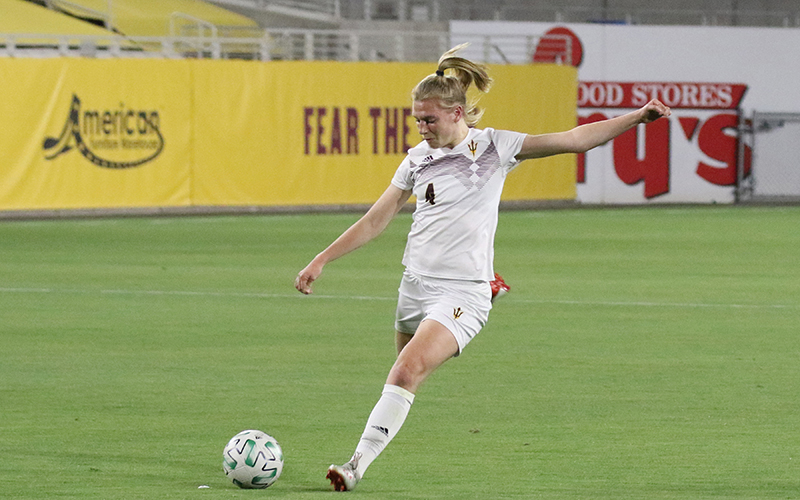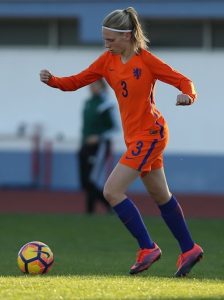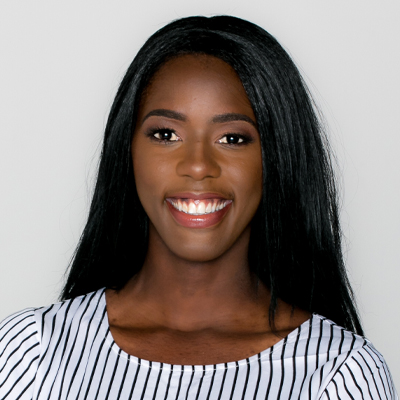
Liekse Carleer says her communication on the field can be perceived as “quick and harsh,” but that’s the style in her native Netherlands. With the help of bonding activities and time, her ASU teammates have come to love her, head coach Graham Winkworth says. (Photo courtesy of ASU Women’s Soccer)
TEMPE – Lieske Carleer doesn’t hold back when she takes the field.
Her communication as a defender for ASU women’s soccer – whether it’s her voice, hand signals or her presence on the ball – may come off as “quick and harsh” to some. But a team with an international roster has come to know “she means well,” despite her directness, she said.
“It’s always a challenge to communicate with other cultures,” Carleer said. “How I would take something, I would be fine, but another person might not be.”
The world’s most popular sport often attracts diverse players to the U.S. The ASU team’s 31-player roster has 13 international players from nine countries.
The junior, who hails from Winterswijk, Netherlands, recalled how moving to Arizona her freshman year was an adjustment – from soccer to food to interactions with teammates.
But head coach Graham Winkworth said Carleer’s versatility and leadership skills were evident from the start.
“We’ve used her as a leader from day one,” Winkworth said. “She still has plenty of areas for growth – and she knows that – which makes her more of a professional in my mind.”
However, the communication and understanding between Carleer, a central defender, and her teammates took some time to build.
“In the Netherlands,” she said, “we are very direct, especially on the field. You communicate quickly and harshly, and everyone knows what is expected of them.
“And coming here (to the U.S.) everyone was like, ‘Dang, OK, she’s going for it.’”
It was the team building activities such as cafe visits, movies and game nights that helped Carleer and her teammates better understand one another. She recalled a memorable road trip to Dana Point, California, with the team. Even though she had never surfed, she said “trying to catch a few waves” was a neat experience with her teammates.
Callie Darst, a junior who has played along the backline with Carleer, considers her a great role model. But on a team with many international players, some serious conversations needed to happen.
“I think eventually it came to a conversation that we had to have, like ‘Hey, this is what we’re used to,’” Darst said of differing communication styles. “But now we know and, honestly, it has been good to merge the two styles.”
Winkworth said Dutch people can come across as abrupt, but after the team came to understand Carleer, they loved her.
“Lieske is a very knowledgeable type of player, so when she speaks, teammates listen,” he said.
The coach said it’s not just the way she communicates with her team, but she also seeks to understand her teammates and coaches.

Lieske Carleer’s soccer experiences playing in the Netherlands and the United States have helped the ASU Women’s Soccer team to an 8-1-1 start this season. (Photo courtesy of ASU Women’s Soccer)
Carleer’s leadership, soccer skills and experience playing in the Netherlands and the U.S., with their different soccer styles, have helped ASU to an 8-1-1 start this season.
“Back home, we focus a lot on tactics – technical ability – and less about the physical side and the desire and the culture around it,” Carleer said.
The defender has represented her U-17 and U-19 national team, and in 2019 played in the UEFA Women’s U-19 Championship.
Winkworth said the Dutch defender has still maintained her possession style of play but has adapted to the American style – playing faster and more physically.
But soccer wasn’t the only adjustment.
In the Netherlands, Dutch is the primary language but English, French and German are spoken in major cities.
Carleer, a student of Barrett, the Honors College at ASU who studies kinesiology, remembered how tough it was taking her first English class. Although she had taken English courses in the Netherlands, reading, writing and formulating ideas in English initially was challenging.
Another adjustment was the American food culture, which was distinctly different from what she was used to – at least in some ways.
“The biggest difference is that we actually cook back home,” Carleer said, “and I feel like Americans just go out to eat all the time. Or grab a bite here and there.”
She added that her family doesn’t always eat the typical Dutch meal – potatoes, meat and veggies. They enjoy a wide array of cuisines from different countries, but they always prepare the food as a family.
Family time and dinner are important for her parents and two siblings.

Lieske Carleer spends most weekends chatting on Facetime with her family in the Netherlands. Despite the challenges of being so far away, her ASU soccer family has helped her feel comfortable living in Arizona. (Photo courtesy of Lieske Carleer)
“I feel like in America, it’s all about time efficiency. Everyone is like ‘time is money.’ Like I don’t have time to eat,” she said.
Carleer said American food can be found in the Netherlands, but she had never tried acai bowls before moving to the U.S.—and she loves them. Some traditional American food, however, isn’t to her liking.
“Mac and cheese are just not my favorite. I would never order that myself. I don’t get what is so good about it,” she said, chuckling.
Despite the differences living in the states, she has a family in both countries. Her Dutch family, who she Facetimes for long periods on the weekend, and her ASU soccer family.
“Of course, sometimes you want a hug (from my family in the Netherlands), but right now I have built a family over here,” Carleer said.
The defender’s dream is to play professional soccer in Europe, and to be chosen for the Netherlands’ national soccer team. But for now, her focus is to help her team make another push for the NCAA tournament come November.
Aside from Carleer’s soccer dreams, her teammate says her admiration goes beyond the field.
“There’s more that meets the eyes,” Darst said. “I think it’s easy to see her as a soccer player and super competitive, and has dedicated her life to this sport, basically.
“But the more people start to get to know her, like she is a really awesome person beyond soccer.”

